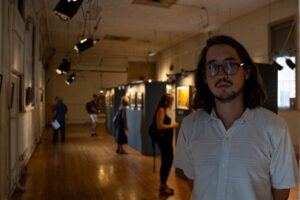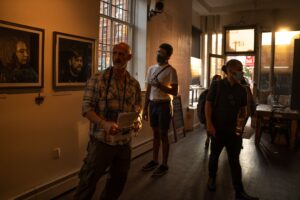A new exhibit at the Bronx Documentary Center highlights life in Latin America through the eyes of photojournalists from the continent, who have a foothold in New York. The 4th Annual Bronx Documentary Center Latin American Foto Festival opened last Thursday, filling the Center’s 614 Courtlandt Avenue galleries, as well as neighboring blocks.
Banners adorned with details about the exhibits and the photos, hung on fences and gates around Melrose, inviting residents with or without ties to Latin America.
“I think it’s really about making the connection between The Bronx and Latin America, which has always been super strong,” said Michael Kamber, founder and executive director of the Bronx Documentary Center. “I think it’s been really powerful. People come and they say, ‘it’s connecting me with my country, it’s giving me insight into what’s happening in my homeland.’”
Locals were welcome to amble among the works and interact with the featured photographers, who had come to lend context to their works. Social issues, such as the effects of the pandemic, domestic and military violence, and rural isolation were a uniting theme, but the intensity of those themes didn’t stop South Bronx residents from chatting in a relaxed atmosphere with friends and colleagues on opening night.

Luis Antonio Rojas, a Mexican photographer whose work has been featured in The New York Times and The Wall Street Journal, among other publications, presented his “Losing Control” collection, with photos he took while documenting the effects of organized crime in Mexico for the Washington Post. They range from small, intimate moments to dramatic scenes Rojas hope will provide viewers a sense of shared struggle.
“I grew up in a pretty safe place in Mexico, considerably, and I was always unsure on how to speak about this subject, or if I had to,” said Rojas. “I think everybody suffers a kind of violence, in a way. Whether it be in the Bronx or in [Mexico], and I think these stories can inspire people from here, or people in Guerrero, we can relate within our personal stories.”
Carlos Saavedra, of Colombia, exhibited a project he created in collaboration with residents of an isolated community called La Isla in the Colombian mountains, which he named his project after. The area lacks government presence, forcing local residents to fend for themselves, including vigilantes who execute criminals and drug users, as well as LGBTQ people and political activists, in a process locals refer to as“social cleansing.”
“I always compare them to Batman, because Batman is a paramilitary. He’s a guy with a lot of money, who arms himself and decides what is good and what is bad,” said Saavedra. “But the thing about Batman is that he has a so-called ‘perfect moral.’ It’s crazy because the guys who do this also build the libraries, build the schools, but they also kill people.”
Saavedra, who has exhibited all over the world, says he always tries to form relationships with his subjects. In La Isla, he taught workshops on the basics of photography, using disposable cameras given out to local participants. Thanks to their enthusiasm, Saaverda was able to see and present images of local life he says he would never have found access to otherwise.
Award-winning Venezuelan photojournalist Andrea Hernández Briceño presented from her series “Mango Season,” the harvest season which began in March, coinciding with the beginning of the pandemic in Venezuela.
While covering breaking news at the time, Hernández-Briceño decided to challenge herself by learning how to develop color film: a very different and often arduous task, even for an accomplished professional. But while working in her home country during the pandemic, she said she needed the change of pace.

“I needed to, in a way, take a different look on things. So instead of looking at the bigger picture, as breaking news makes you do, I started to look at small details and moments that spoke about this period in Venezuela,” said Hernández-Briceño. “I found that people were surviving and solving their everyday problems, going back to their roots. People started growing crops where they could.”
Public festivals in struggling communities, where residents get a chance to examine new angles to familiar but daunting challenges, are very important, said Hernández Briceño.
“Perspective is always important, and photography gives you that.”

